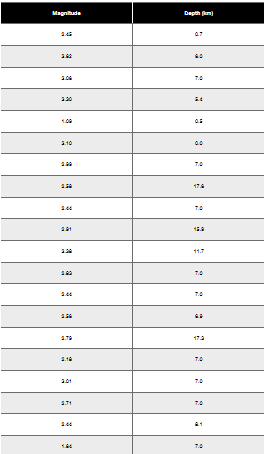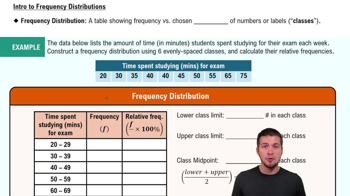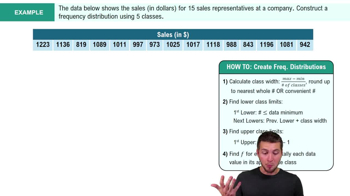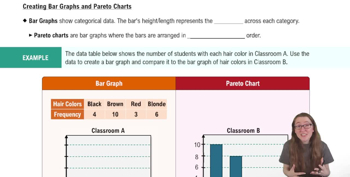Births Natural births randomly selected from four hospitals in New York State occurred on the days of the week (in the order of Monday through Sunday) with these frequencies: 52, 66, 72, 57, 57, 43, 53. Does it appear that such births occur on the days of the week with equal frequency?
Table of contents
- 1. Intro to Stats and Collecting Data1h 14m
- 2. Describing Data with Tables and Graphs1h 55m
- 3. Describing Data Numerically2h 5m
- 4. Probability2h 16m
- 5. Binomial Distribution & Discrete Random Variables3h 6m
- 6. Normal Distribution and Continuous Random Variables2h 11m
- 7. Sampling Distributions & Confidence Intervals: Mean3h 23m
- Sampling Distribution of the Sample Mean and Central Limit Theorem19m
- Distribution of Sample Mean - Excel23m
- Introduction to Confidence Intervals15m
- Confidence Intervals for Population Mean1h 18m
- Determining the Minimum Sample Size Required12m
- Finding Probabilities and T Critical Values - Excel28m
- Confidence Intervals for Population Means - Excel25m
- 8. Sampling Distributions & Confidence Intervals: Proportion1h 12m
- 9. Hypothesis Testing for One Sample3h 29m
- 10. Hypothesis Testing for Two Samples4h 50m
- Two Proportions1h 13m
- Two Proportions Hypothesis Test - Excel28m
- Two Means - Unknown, Unequal Variance1h 3m
- Two Means - Unknown Variances Hypothesis Test - Excel12m
- Two Means - Unknown, Equal Variance15m
- Two Means - Unknown, Equal Variances Hypothesis Test - Excel9m
- Two Means - Known Variance12m
- Two Means - Sigma Known Hypothesis Test - Excel21m
- Two Means - Matched Pairs (Dependent Samples)42m
- Matched Pairs Hypothesis Test - Excel12m
- 11. Correlation1h 6m
- 12. Regression1h 50m
- 13. Chi-Square Tests & Goodness of Fit1h 57m
- 14. ANOVA1h 57m
2. Describing Data with Tables and Graphs
Frequency Distributions
Problem 2.c.1
Textbook Question
In Exercises 1–5, use the data listed in the margin, which are magnitudes (Richter scale) and depths (km) of earthquakes from Data Set 24 “Earthquakes” in Appendix B

Frequency Distribution Construct a frequency distribution of the magnitudes. Use a class width of 0.50 and use a starting value of 1.00.
 Verified step by step guidance
Verified step by step guidance1
Step 1: Identify the range of magnitudes in the dataset. Look at the smallest and largest values in the 'Magnitude' column from the table provided. This will help determine the number of classes needed for the frequency distribution.
Step 2: Determine the class width. The problem specifies a class width of 0.50, and the starting value is 1.00. Create intervals starting from 1.00, such as [1.00–1.50), [1.50–2.00), [2.00–2.50), and so on, until the largest magnitude is covered.
Step 3: Count the number of magnitudes that fall into each interval. For each interval, go through the 'Magnitude' column and tally how many values fall within that range. Ensure that the intervals are non-overlapping and exhaustive.
Step 4: Construct the frequency distribution table. Create a table with two columns: one for the intervals (e.g., [1.00–1.50), [1.50–2.00), etc.) and another for the frequency (the count of magnitudes in each interval).
Step 5: Verify the frequency distribution. Ensure that the sum of the frequencies equals the total number of magnitudes in the dataset. This confirms that all data points have been accounted for.
 Verified video answer for a similar problem:
Verified video answer for a similar problem:This video solution was recommended by our tutors as helpful for the problem above
Video duration:
3mPlay a video:
Was this helpful?
Key Concepts
Here are the essential concepts you must grasp in order to answer the question correctly.
Frequency Distribution
A frequency distribution is a summary of how often each value occurs in a dataset. It organizes data into classes or intervals, allowing for easier analysis of patterns and trends. In this case, the magnitudes of earthquakes will be grouped into intervals of 0.50, which helps visualize the distribution of earthquake magnitudes.
Recommended video:
Guided course

Intro to Frequency Distributions
Class Width
Class width refers to the size of the intervals used in a frequency distribution. It determines how data points are grouped together. For this exercise, a class width of 0.50 means that each interval will cover a range of 0.50 units, starting from the specified value of 1.00, which helps in organizing the data systematically.
Recommended video:
Guided course

How to Create Frequency Distributions Example 2
Richter Scale
The Richter scale is a logarithmic scale used to measure the magnitude of earthquakes. It quantifies the amount of energy released during an earthquake, with each whole number increase on the scale representing a tenfold increase in measured amplitude and approximately 31.6 times more energy release. Understanding this scale is crucial for interpreting the magnitudes listed in the dataset.
Recommended video:

Creating Bar Graphs and Pareto Charts

 6:38m
6:38mWatch next
Master Intro to Frequency Distributions with a bite sized video explanation from Patrick
Start learningRelated Videos
Related Practice
Textbook Question
